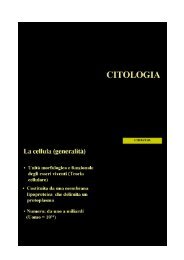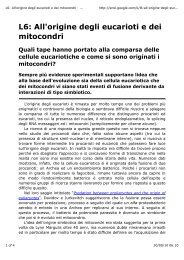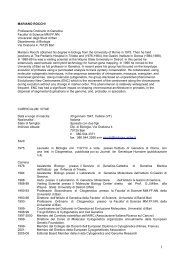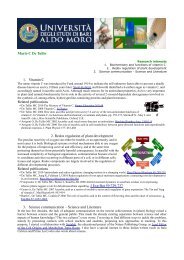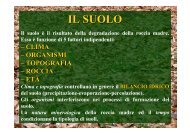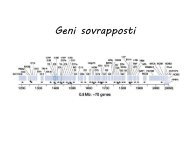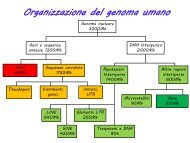mitochondrial dna mutations in human disease - The Rare ...
mitochondrial dna mutations in human disease - The Rare ...
mitochondrial dna mutations in human disease - The Rare ...
Create successful ePaper yourself
Turn your PDF publications into a flip-book with our unique Google optimized e-Paper software.
REVIEWS<br />
This report describes a knock-<strong>in</strong> mouse model that<br />
expresses a proof-read<strong>in</strong>g-deficient version of PolgA,<br />
the catalytic subunit of mtDNA polymerase, and<br />
provides the first <strong>in</strong> vivo data <strong>in</strong> mammals to establish<br />
a causative l<strong>in</strong>k between mtDNA <strong>mutations</strong> and<br />
age<strong>in</strong>g phenotypes.<br />
11. Muller-Hocker, J. Cytochrome c oxidase deficient fibres <strong>in</strong><br />
the limb muscle and diaphragm of man without muscular<br />
<strong>disease</strong>: an age-related alteration. J. Neurol. Sci. 100,<br />
14–21 (1990).<br />
12. Mootha, V. K. et al. PGC-1α-responsive genes <strong>in</strong>volved <strong>in</strong><br />
oxidative phosphorylation are coord<strong>in</strong>ately downregulated<br />
<strong>in</strong> <strong>human</strong> diabetes. Nature Genet. 34, 267–273 (2003).<br />
13. Petersen, K. F. et al. Mitochondrial dysfunction <strong>in</strong> the<br />
elderly: possible role <strong>in</strong> <strong>in</strong>sul<strong>in</strong> resistance. Science 300,<br />
1140–1142 (2003).<br />
14. DiMauro, S. & Schon, E. A. Mitochondrial respiratory-cha<strong>in</strong><br />
<strong>disease</strong>s. N. Engl. J. Med. 348, 2656–2668 (2003).<br />
15. Shoubridge, E. A. Nuclear genetic defects of oxidative<br />
phosphorylation. Hum. Mol. Genet. 10, 2277–2284 (2001).<br />
16. Lang, B. F., Gray, M. W. & Burger, G. Mitochondrial genome<br />
evolution and the orig<strong>in</strong> of eukaryotes. Annu. Rev. Genet.<br />
33, 351–397 (1999).<br />
17. Korhonen, J. A., Pham, X. H., Pellegr<strong>in</strong>i, M. & Falkenberg, M.<br />
Reconstitution of a m<strong>in</strong>imal mtDNA replisome <strong>in</strong> vitro.<br />
EMBO J. 23, 2423–2429 (2004).<br />
18. Carrodeguas, J. A., <strong>The</strong>is, K., Bogenhagen, D. F. & Kisker, C.<br />
Crystal structure and deletion analysis show that the<br />
accessory subunit of mammalian DNA polymerase-γ, PolγB,<br />
functions as a homodimer. Mol. Cell 7, 43–54 (2001).<br />
19. Spelbr<strong>in</strong>k, J. N. et al. Human <strong>mitochondrial</strong> DNA deletions<br />
associated with <strong>mutations</strong> <strong>in</strong> the gene encod<strong>in</strong>g Tw<strong>in</strong>kle,<br />
a phage T7 gene 4-like prote<strong>in</strong> localized <strong>in</strong> mitochondria.<br />
Nature Genet. 28, 223–231 (2001).<br />
20. Clayton, D. A. Replication of animal <strong>mitochondrial</strong> DNA. Cell<br />
28, 693–705 (1982).<br />
This paper outl<strong>in</strong>es the strand-displacement model<br />
of mammalian mtDNA replication, <strong>in</strong> which the two<br />
strands of mtDNA are each replicated <strong>in</strong> a cont<strong>in</strong>uous<br />
fashion from widely separated orig<strong>in</strong>s, requir<strong>in</strong>g<br />
extensive displacement of parental DNA strands<br />
dur<strong>in</strong>g lead<strong>in</strong>g-strand synthesis.<br />
21. Holt, I. J., Lorimer, H. E. & Jacobs, H. T. Coupled lead<strong>in</strong>gand<br />
lagg<strong>in</strong>g-strand synthesis of mammalian <strong>mitochondrial</strong><br />
DNA. Cell 100, 515–524 (2000).<br />
Us<strong>in</strong>g two-dimensional agarose gel electrophoresis,<br />
the demonstration of duplex replication<br />
<strong>in</strong>termediates led the authors to propose a further<br />
mechanism for mammalian mtDNA replication that<br />
<strong>in</strong>volves strand-coupled synthesis.<br />
22. Yang, M. Y. et al. Biased <strong>in</strong>corporation of ribonucleotides on<br />
the <strong>mitochondrial</strong> L-strand accounts for apparent strandasymmetric<br />
DNA replication. Cell 111, 495–505 (2002).<br />
23. Bowmaker, M. et al. Mammalian <strong>mitochondrial</strong> DNA<br />
replicates bidirectionally from an <strong>in</strong>itiation zone. J. Biol.<br />
Chem. 278, 50961–50969 (2003).<br />
24. Bogenhagen, D. F. & Clayton, D. A. <strong>The</strong> <strong>mitochondrial</strong> DNA<br />
replication bubble has not burst. Trends Biochem. Sci. 28,<br />
357–360 (2003).<br />
25. Holt, I. J. & Jacobs, H. T. Response: <strong>The</strong> <strong>mitochondrial</strong><br />
DNA replication bubble has not burst. Trends Biochem. Sci.<br />
28, 355–356 (2003).<br />
26. Bogenhagen, D. F. & Clayton, D. A. Conclud<strong>in</strong>g remarks:<br />
<strong>The</strong> <strong>mitochondrial</strong> DNA replication bubble has not burst.<br />
Trends Biochem. Sci. 28, 404–405 (2003).<br />
27. Fish, J., Raule, N. & Attardi, G. Discovery of a major D-loop<br />
replication orig<strong>in</strong> reveals two modes of <strong>human</strong> mtDNA<br />
synthesis. Science 306, 2098–2101 (2004).<br />
28. Gaspari, M., Larsson, N. G. & Gustafsson, C. M. <strong>The</strong><br />
transcription mach<strong>in</strong>ery <strong>in</strong> mammalian mitochondria.<br />
Biochim. Biophys. Acta 1659, 148–152 (2004).<br />
29. Clayton, D. A. Replication and transcription of vertebrate<br />
<strong>mitochondrial</strong> DNA. Annu. Rev. Cell Biol. 7, 453–478 (1991).<br />
30. Ojala, D., Montoya, J. & Attardi, G. tRNA punctuation model<br />
of RNA process<strong>in</strong>g <strong>in</strong> <strong>human</strong> mitochondria. Nature 290,<br />
470–474 (1981).<br />
31. Falkenberg, M. et al. Mitochondrial transcription factors<br />
B1 and B2 activate transcription of <strong>human</strong> mtDNA. Nature<br />
Genet. 31, 289–294 (2002).<br />
32. Fernandez-Silva, P., Enriquez, J. A. & Montoya, J.<br />
Replication and transcription of mammalian <strong>mitochondrial</strong><br />
DNA. Exp. Physiol. 88, 41–56 (2003).<br />
33. Gaspari, M., Falkenberg, M., Larsson, N. G. &<br />
Gustafsson, C. M. <strong>The</strong> <strong>mitochondrial</strong> RNA polymerase<br />
contributes critically to promoter specificity <strong>in</strong> mammalian<br />
cells. EMBO J. 23, 4606–4614 (2004).<br />
34. Jacobs, H. T. Disorders of <strong>mitochondrial</strong> prote<strong>in</strong> synthesis.<br />
Hum. Mol. Genet. 12, R293–R301 (2003).<br />
35. Miller, C. et al. Defective <strong>mitochondrial</strong> translation caused<br />
by a ribosomal prote<strong>in</strong> (MRPS16) mutation. Ann. Neurol.<br />
56, 734–738 (2004).<br />
36. Coenen, M. J. et al. Mutant <strong>mitochondrial</strong> elongation factor<br />
G1 and comb<strong>in</strong>ed oxidative phosphorylation deficiency.<br />
N. Engl. J. Med. 351, 2080–2086 (2004).<br />
37. Sciacco, M., Bonilla, E., Schon, E. A., DiMauro, S. &<br />
Moraes, C. T. Distribution of wild-type and common deletion<br />
forms of mtDNA <strong>in</strong> normal and respiration-deficient muscle<br />
fibers from patients with <strong>mitochondrial</strong> myopathy. Hum. Mol.<br />
Genet. 3, 13–19 (1994).<br />
A study of <strong>in</strong>dividual muscle fibres from patients<br />
with <strong>mitochondrial</strong> myopathy caused by large-scale<br />
mtDNA rearrangements revealed that, <strong>in</strong> addition<br />
to levels of deleted mtDNA that are above a critical<br />
threshold, respiratory-deficient fibres exhibit a<br />
marked reduction <strong>in</strong> the absolute amount of<br />
wild-type mtDNA.<br />
38. Coller, H. A. et al. High frequency of homoplasmic<br />
<strong>mitochondrial</strong> DNA <strong>mutations</strong> <strong>in</strong> <strong>human</strong> tumors can be<br />
expla<strong>in</strong>ed without selection. Nature Genet. 28, 147–150<br />
(2001).<br />
39. Taylor, R. W. et al. Mitochondrial DNA <strong>mutations</strong> <strong>in</strong> <strong>human</strong><br />
colonic crypt stem cells. J. Cl<strong>in</strong>. Invest. 112, 1351–1360<br />
(2003).<br />
40. Giles, R. E., Blanc, H., Cann, H. M. & Wallace, D. C. Maternal<br />
<strong>in</strong>heritance of <strong>human</strong> <strong>mitochondrial</strong> DNA. Proc. Natl Acad.<br />
Sci. USA 77, 6715–6719 (1980).<br />
41. Gyllensten, U., Wharton, D., Josefsson, A. & Wilson, A. C.<br />
Paternal <strong>in</strong>heritance of <strong>mitochondrial</strong> DNA <strong>in</strong> mice. Nature<br />
352, 255–257 (1991).<br />
42. Shitara, H., Hayashi, J. I., Takahama, S., Kaneda, H. &<br />
Yonekawa, H. Maternal <strong>in</strong>heritance of mouse mtDNA <strong>in</strong><br />
<strong>in</strong>terspecific hybrids: segregation of the leaked paternal<br />
mtDNA followed by the prevention of subsequent paternal<br />
leakage. Genetics 148, 851–857 (1998).<br />
43. Awadalla, P., Eyre-Walker, A. & Smith, J. M. L<strong>in</strong>kage<br />
disequilibrium and recomb<strong>in</strong>ation <strong>in</strong> hom<strong>in</strong>id <strong>mitochondrial</strong><br />
DNA. Science 286, 2524–2525 (1999).<br />
44. D’Aurelio, M. et al. Heterologous <strong>mitochondrial</strong> DNA<br />
recomb<strong>in</strong>ation <strong>in</strong> <strong>human</strong> cells. Hum. Mol. Genet. 13, 3171–<br />
3179 (2004).<br />
45. Kraytsberg, Y. et al. Recomb<strong>in</strong>ation of <strong>human</strong> <strong>mitochondrial</strong><br />
DNA. Science 304, 981 (2004).<br />
46. Elson, J. L. et al. Analysis of European mtDNAs for<br />
recomb<strong>in</strong>ation. Am. J. Hum. Genet. 68, 145–153 (2001).<br />
47. Schwartz, M. & Viss<strong>in</strong>g, J. Paternal <strong>in</strong>heritance of<br />
<strong>mitochondrial</strong> DNA. N. Engl. J. Med. 347, 576–580 (2002).<br />
48. Taylor, R. W. et al. Genotypes from patients <strong>in</strong>dicate no<br />
paternal <strong>mitochondrial</strong> DNA contribution. Ann. Neurol. 54,<br />
521–524 (2003).<br />
49. Filosto, M. et al. Lack of paternal <strong>in</strong>heritance of muscle<br />
<strong>mitochondrial</strong> DNA <strong>in</strong> sporadic <strong>mitochondrial</strong> myopathies.<br />
Ann. Neurol. 54, 524–526 (2003).<br />
50. Schwartz, M. & Viss<strong>in</strong>g, J. No evidence for paternal<br />
<strong>in</strong>heritance of mtDNA <strong>in</strong> patients with sporadic mtDNA<br />
<strong>mutations</strong>. J. Neurol. Sci. 218, 99–101 (2004)<br />
51. Danan, C. et al. Evaluation of parental <strong>mitochondrial</strong><br />
<strong>in</strong>heritance <strong>in</strong> neonates born after <strong>in</strong>tracytoplasmic sperm<br />
<strong>in</strong>jection. Am. J. Hum. Genet. 65, 463–473 (1999).<br />
52. March<strong>in</strong>gton, D. R. et al. No evidence for paternal mtDNA<br />
transmission to offspr<strong>in</strong>g or extra-embryonic tissues after<br />
ICSI. Mol. Hum. Reprod. 8, 1046–1049 (2002).<br />
53. Ch<strong>in</strong>nery, P. F. et al. Risk of develop<strong>in</strong>g a <strong>mitochondrial</strong> DNA<br />
deletion disorder. Lancet 364, 592–596 (2004).<br />
54. Man, P. Y. et al. <strong>The</strong> epidemiology of Leber hereditary optic<br />
neuropathy <strong>in</strong> the North East of England. Am. J. Hum. Genet.<br />
72, 333–339 (2003).<br />
55. Prezant, T. R. et al. Mitochondrial ribosomal RNA mutation<br />
associated with both antibiotic-<strong>in</strong>duced and non-syndromic<br />
deafness. Nature Genet. 4, 289–294 (1993).<br />
56. Battersby, B. J., Loredo-Osti, J. C. & Shoubridge, E. A.<br />
Nuclear genetic control of <strong>mitochondrial</strong> DNA segregation.<br />
Nature Genet. 33, 183–186 (2003).<br />
57. Brown, D. T., Samuels, D. C., Michael, E. M., Turnbull, D. M.<br />
& Ch<strong>in</strong>nery, P. F. Random genetic drift determ<strong>in</strong>es the level<br />
of mutant mtDNA <strong>in</strong> <strong>human</strong> primary oocytes. Am. J. Hum.<br />
Genet. 68, 533–536 (2000).<br />
58. Poulton, J. & Turnbull, D. M. 74th ENMC <strong>in</strong>ternational<br />
workshop: <strong>mitochondrial</strong> <strong>disease</strong>s 19–20 November 1999,<br />
Naarden, the Netherlands. Neuromuscul. Disord. 10,<br />
460–462 (2000).<br />
59. Taylor, R. W., Schaefer, A. M., Barron, M. J., McFarland, R.<br />
& Turnbull, D. M. <strong>The</strong> diagnosis of <strong>mitochondrial</strong> muscle<br />
<strong>disease</strong>. Neuromuscul. Disord. 14, 237–245 (2004).<br />
60. McFarland, R., Elson, J. L., Taylor, R. W., Howell, N. &<br />
Turnbull, D. M. Assign<strong>in</strong>g pathogenicity to <strong>mitochondrial</strong><br />
tRNA <strong>mutations</strong>: when ‘def<strong>in</strong>itely maybe’ is not good<br />
enough. Trends Genet. 20, 591–596 (2004).<br />
61. Holt, I. J., Hard<strong>in</strong>g, A. E. & Morgan-Hughes, J. A. Deletions<br />
of muscle <strong>mitochondrial</strong> DNA <strong>in</strong> patients with <strong>mitochondrial</strong><br />
myopathies. Nature 331, 717–719 (1988).<br />
<strong>The</strong> first demonstration that heteroplasmic, largescale<br />
rearrangements of the <strong>mitochondrial</strong> genome<br />
could cause <strong>human</strong> <strong>disease</strong>.<br />
62. Wallace, D. C. et al. Mitochondrial DNA mutation<br />
associated with Leber’s hereditary optic neuropathy.<br />
Science 242, 1427–1430 (1988).<br />
This paper describes the first example of a s<strong>in</strong>glenucleotide<br />
change <strong>in</strong> the <strong>mitochondrial</strong> genome<br />
(11778G>A) as the cause of a maternally <strong>in</strong>herited,<br />
neurological disorder <strong>in</strong> multiple families.<br />
63. Brandon, M. C. et al. MITOMAP: a <strong>human</strong> <strong>mitochondrial</strong><br />
genome database — 2004 update. Nucleic Acids Res. 33,<br />
D611–D613 (2005).<br />
64. Moraes, C. T. et al. Mitochondrial DNA deletions <strong>in</strong><br />
progressive external ophthalmoplegia and Kearns–Sayre<br />
syndrome. N. Engl. J. Med. 320, 1293–1299 (1989).<br />
65. Rotig, A., Cormier, V., Blanche, S., Bonnefont, J.-P. &<br />
Ledeist, F. Pearson’s marrow pancreas syndrome. A<br />
multisystem <strong>mitochondrial</strong> disorder of <strong>in</strong>fancy. J. Cl<strong>in</strong>.<br />
Invest. 86, 1601–1608 (1990).<br />
66. McFarland, R. et al. De novo <strong>mutations</strong> <strong>in</strong> the <strong>mitochondrial</strong><br />
ND3 gene as a cause of <strong>in</strong>fantile <strong>mitochondrial</strong><br />
encephalopathy and complex I deficiency. Ann. Neurol. 55,<br />
58–64 (2004).<br />
67. de Vries, D. D., van Engelen, B. G., Gabreels, F. J.,<br />
Ruitenbeek, W. & van Oost, B. A. A second missense<br />
mutation <strong>in</strong> the <strong>mitochondrial</strong> ATPase 6 gene <strong>in</strong> Leigh’s<br />
syndrome. Ann. Neurol. 34, 410–412 (1993).<br />
68. Andreu, A. L. et al. Exercise <strong>in</strong>tolerance due to <strong>mutations</strong> <strong>in</strong><br />
the cytochrome b gene of <strong>mitochondrial</strong> DNA. N. Engl. J.<br />
Med. 341, 1037–1044 (1999).<br />
69. Lowell, B. B. & Shulman, G. I. Mitochondrial dysfunction<br />
and type 2 diabetes. Science 307, 384–387 (2005).<br />
70. Maassen, J. A. et al. Mitochondrial diabetes: molecular<br />
mechanisms and cl<strong>in</strong>ical presentation. Diabetes 53 (Suppl.<br />
1), 103–109 (2004).<br />
71. Saker, P. J. et al. UKPDS 21: low prevalence of the<br />
<strong>mitochondrial</strong> transfer RNA gene (tRNA Leu(UUR) ) mutation at<br />
position 3243bp <strong>in</strong> UK Caucasian type 2 diabetic patients.<br />
Diabet. Med. 14, 42–45 (1997).<br />
72. Ohkubo, K. et al. Mitochondrial gene <strong>mutations</strong> <strong>in</strong> the<br />
tRNA Leu(UUR) region and diabetes: prevalence and cl<strong>in</strong>ical<br />
phenotypes <strong>in</strong> Japan. Cl<strong>in</strong>. Chem. 47, 1641–1648<br />
(2001).<br />
73. Kearney, P. M. et al. Global burden of hypertension:<br />
analysis of worldwide data. Lancet 365, 217–223<br />
(2005).<br />
74. Ch<strong>in</strong>nery, P. F. et al. <strong>The</strong> epidemiology of pathogenic<br />
<strong>mitochondrial</strong> DNA <strong>mutations</strong>. Ann. Neurol. 48, 188–193<br />
(2000).<br />
75. Choo-Kang, A. T. et al. Def<strong>in</strong><strong>in</strong>g the importance of<br />
<strong>mitochondrial</strong> gene defects <strong>in</strong> maternally <strong>in</strong>herited diabetes<br />
by sequenc<strong>in</strong>g the entire <strong>mitochondrial</strong> genome. Diabetes<br />
51, 2317–2320 (2002).<br />
76. Wallace, D. C. Mitochondrial genetics: a paradigm for<br />
ag<strong>in</strong>g and degenerative <strong>disease</strong>s? Science 256, 628–632<br />
(1992).<br />
77. Herrnstadt, C. et al. Reduced-median-network analysis of<br />
complete <strong>mitochondrial</strong> DNA cod<strong>in</strong>g-region sequences for<br />
the major African, Asian, and European haplogroups. Am.<br />
J. Hum. Genet. 70, 1152–1171 (2002).<br />
78. Khogali, S. S. et al. A common <strong>mitochondrial</strong> DNA variant<br />
associated with susceptibility to dilated cardiomyopathy<br />
<strong>in</strong> two different populations. Lancet 357, 1265–1267<br />
(2001).<br />
79. Poulton, J. et al. Type 2 diabetes is associated with a<br />
common <strong>mitochondrial</strong> variant: evidence from a populationbased<br />
case-control study. Hum. Mol. Genet. 11, 1581–<br />
1583 (2002).<br />
80. Torroni, A. et al. Classification of European mtDNAs from<br />
an analysis of three European populations. Genetics 144,<br />
1835–1850 (1996).<br />
81. Chagnon, P. et al. Phylogenetic analysis of the<br />
<strong>mitochondrial</strong> genome <strong>in</strong>dicates significant differences<br />
between patients with Alzheimer <strong>disease</strong> and controls <strong>in</strong> a<br />
French-Canadian founder population. Am. J. Med. Genet.<br />
85, 20–30 (1999).<br />
82. van der Walt, J. M. et al. Analysis of European <strong>mitochondrial</strong><br />
haplogroups with Alzheimer <strong>disease</strong> risk. Neurosci. Lett.<br />
365, 28–32 (2004).<br />
83. Ross, O. A. et al. mt4216C variant <strong>in</strong> l<strong>in</strong>kage with<br />
the mtDNA TJ cluster may confer a susceptibility to<br />
<strong>mitochondrial</strong> dysfunction result<strong>in</strong>g <strong>in</strong> an <strong>in</strong>creased risk of<br />
Park<strong>in</strong>son’s <strong>disease</strong> <strong>in</strong> the Irish. Exp. Gerontol. 38, 397–405<br />
(2003).<br />
84. van der Walt, J. M. et al. Mitochondrial polymorphisms<br />
significantly reduce the risk of Park<strong>in</strong>son <strong>disease</strong>. Am. J.<br />
Hum. Genet. 72, 804–811 (2003).<br />
85. Helgason, A., Yngvadóttir, B., Hrafnkelsson, B., Gulcher,<br />
J. & Stefánsson, K. An Icelandic example of the impact of<br />
population structure on association studies. Nature Genet.<br />
37, 90–95 (2005).<br />
400 | MAY 2005 | VOLUME 6 www.nature.com/reviews/genetics<br />
© 2005 Nature Publish<strong>in</strong>g Group





